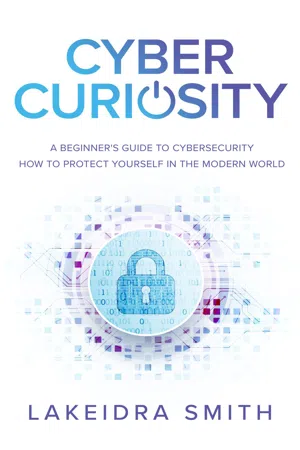
Cyber Curiosity
A Beginner's Guide to Cybersecurity - How to Protect Yourself in the Modern World
- English
- ePUB (mobile friendly)
- Available on iOS & Android
Cyber Curiosity
A Beginner's Guide to Cybersecurity - How to Protect Yourself in the Modern World
About this book
Every year, thousands of people fall victim to phone scams, phishing attacks, and identity theft. But the consequences of these attacks are completely preventable if you practice cybersecurity awareness.
Many associate cybersecurity with large corporations, so why is it important for you? Cyber Curiosity: A Beginner's Guide to Cybersecurity-How to Protect Yourself in the Modern World answers this through the stories of individuals and corporations alike. You will learn why you should keep separate passwords and how cybercrimes are committed. You will read about:
- The couple who set up a smart security camera system only to find that it was recording them for the world to see
- How a ransomware attack brought the DCH hospital system of West Alabama to its knees
- What it's like being a victim of a romance scam resulting in over two million dollars in damages
Cyber Curiosity breaks down these stories and pulls in the experts to help equip you with the tools needed to bolster your own cybersecurity awareness. It's not all about the big tech data breaches on the news-cybersecurity is about making the right decisions to protect yourself, your loved ones, and your information.
Frequently asked questions
- Essential is ideal for learners and professionals who enjoy exploring a wide range of subjects. Access the Essential Library with 800,000+ trusted titles and best-sellers across business, personal growth, and the humanities. Includes unlimited reading time and Standard Read Aloud voice.
- Complete: Perfect for advanced learners and researchers needing full, unrestricted access. Unlock 1.4M+ books across hundreds of subjects, including academic and specialized titles. The Complete Plan also includes advanced features like Premium Read Aloud and Research Assistant.
Please note we cannot support devices running on iOS 13 and Android 7 or earlier. Learn more about using the app.
Information
Part 1
What is Cybersecurity
Chapter 1
Redefining Cybersecurity
Defining Cybersecurity
Table of contents
- Introduction
- Part 1 What is Cybersecurity
- Chapter 1 Redefining Cybersecurity
- Chapter 2 Cybersecurity in Business
- Chapter 3 The Birth of Cyberspace
- Chapter 4 The Cyber Curiosity Mindset
- Part 2 What to Know About Cybersecurity
- Chapter 5 A New Threat Landscape
- Chapter 6 What is PII?
- Chapter 7 Malicious Intent
- Chapter 8 So Social
- Chapter 9 The Privacy Paradox
- Chapter 10 The New Oil
- Part 3 What to Do to Protect Yourself
- Chapter 11 The 3 Cs of Cyber Curiosity
- Chapter 12 Protecting Your PII
- Chapter 13 Protecting Vulnerable Populations
- Conclusion
- Acknowledgments
- Appendix